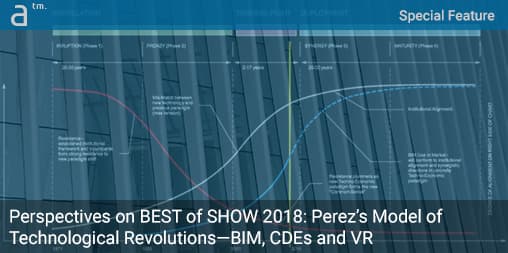Continued from page 1
Part 2: Technological Revolutions: Explaining Carlota Perez’s Theory (or Model)
Introduction: From Bubbles to Golden Ages
Perez is an economic historian specializing in technology and socio-economic developments. Her landmark book, “Technological Revolutions and Financial Capital: The Dynamics of Bubbles and Golden Ages” (2002) has been widely lauded for clarity and insight of its model. Her theory is that there have been five distinct “Techno-Economic Paradigm” shifts since the first industrial revolution in the late 18th century—initiated via five unique technology revolutions. (see image 03 below)
The most remarkable aspect of Perez’s theory—which she labels five great surges of capital and technology—is that they are destined to cycle based on the underlying natures of capitalism itself. Each “great surge”—as she labels different technology revolutions—also has the exact same number of sub-phases. (more on that later. see image 05 below).
Each revolution begins with what she calls the “Installation” period, where dramatic new technologies sponsor a casino-like financial economy where money chases after short-term gains based on rapid growth of new technologies destined to displace exhausted old technologies. The nature of this short-term-minded financial ethos invariably leads to a financial bubble and financial crash. Then society enters a “turning point” which can span from 2-17 years (as in the current phase) before society, led by government, reorients around what she calls the “Deployment” period which leads to a golden age of stable growth based on long-term views of investment capital. (Recommended: click on the chart in image 03 below and read the Five Great Surges and the blue and tan boxes of each.)

03 – Perez’s Techno-Economic Revolutions, which lead to Techno-Economic Paradigms. They tend to span 50-60 years each. There have been five since the start of the Industrial Revolution. We are currently in the 5th Great Surge, called the Information Age or ICT (information communications technology) Revolution. (click on chart to read it in detail)
As you can see in the chart above, each great surge is around 50-60 years long on average. The five great surges were: The Industrial Revolution, the Era of Steam and Railways, the Era of Steel and Heavy Engineering, the Era of the Automobile and Mass Manufacturing, and the Information Age (or ICT Revolution). A good primer on Perez’s theory and commentary on where we are today is found here (video of her lecturing). She refers to our era in terms of ICT (information and communications technology) but it is essentially the era that began with the big bang of the Intel microprocessor in 1971.
New Golden Age? — She Says We Are Close
What is most exciting about Perez’ theory is that she says we are on the cusp of the next golden age of prosperity for all. And this is hugely important. (see her in this lecture explain exactly why) And it ties directly into themes from this year’s AIA National Expo. Now at this point, we suggest to the reader to watch at least one of the two videos just referenced prior to reading the rest of this article. If one, we prefer the second one here. Or carry on and watch them later.
From this perspective, it is worth diving a bit deeper to understand her theories and how they connect—not just to themes from AIA 2018—but to where global societies are with respect to our current set of technologies.

04 – Carlota Perez speaking this June in 2018 at a summit sponsored by the Ellen MacArthur Foundation about why we are on the cusp of the next possible Golden Age.
Carlota Perez has western economies located within the “Turning Point” phase of the 5th Great Surge. (see image 04 above) In other words, this particular surge’s golden age has not yet happened—we are on the cusp of it. We will only get there if certain specific actions take place—actions that have taken place, more or less, every time in the past four great surges. In a nutshell, the State must intervene after great crashes and organize society and its markets and technology around a unified vision. That vision for Perez is “smart green technology” because it is the natural and logical next step, converging our human progress with information age technologies, solving our environmental impact and energy crises, and reshaping how we physically move people, goods, and services on the emerging infrastructure of our age on a globalized level.
AEC’s Relation to Perez via Infrastructure
Every great surge from the Industrial Revolution on has had a galvanizing pivotal invention (or set of inter-related inventions), combining in a three-way matrix with a key fuel and key set of raw materials. The dynamics between them congeal into a new Techno-Economic Paradigm (TEP). (zoom into the chart on image 03)
As for infrastructure—a pivotal member of the dynamic mechanisms of social change—this is where AEC comes into play and where our discussions about technologies shown at the AIA National this year makes sense. In the next section we will bring together three key concepts or discussions:
- The Role of Alignment in Golden Ages
- The next Golden Age: Perez’s Smart Green Future
- Curve Fitting Hype Cycle to Perez—Impacts on Tech
These three brief concepts will empower our current understanding of AEC technologies—adding a critical new lens under which we can better see key technologies in AEC, like BIM, VR, CAD and visualization and collaboration.
next page: Part 3: Towards a Smart Green Future—The Role of AEC







Reader Comments
Comments for this story are closed